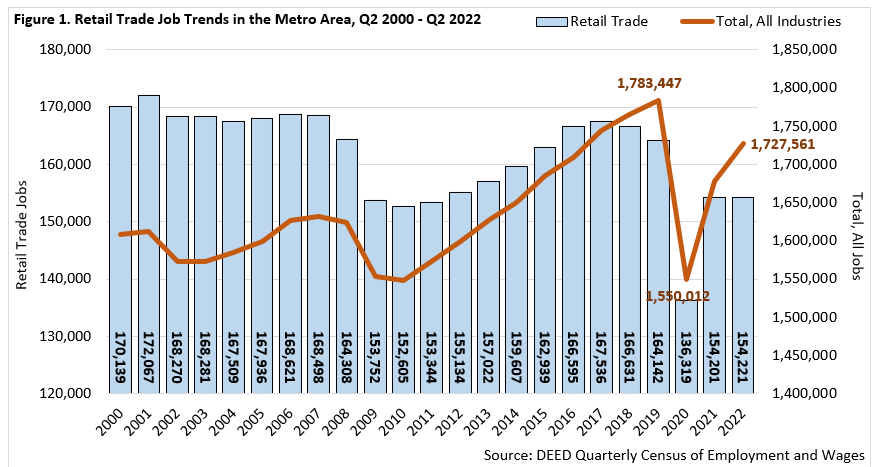 The Minneapolis-St. Paul metropolitan area is a national leader in finance, advanced manufacturing, agriculture and retailing.
The Minneapolis-St. Paul metropolitan area is a national leader in finance, advanced manufacturing, agriculture and retailing.
Medical devices, electronics and processed foods are strong suits recognized globally.
Want the freshest data delivered by email? Subscribe to our regional newsletters.
12/14/2022 9:00:00 AM
Tim O'Neill
With the month of December and the holiday season upon us, let's take a closer look into the Metro Area's Retail Trade employment.
| Table 1. Retail Trade Industry Statistics in the Metro Area, Qtr. 2 2022 | ||||
|---|---|---|---|---|
| Industry | Number of Establishments | Number of Jobs | Share of Total Jobs | Avg. Annual Wage |
| Total, All Industries | 91,366 | 1,727,561 | 100.0% | $73,424 |
| Retail Trade | 8,197 | 154,221 | 8.9% | $39,312 |
| General Merchandise Retailers | 498 | 34,312 | 22.2% | $32,708 |
| Food & Beverage Stores | 1,160 | 29,904 | 19.4% | $29,484 |
| Motor Vehicle & Parts Dealers | 794 | 17,426 | 11.3% | $68,016 |
| Sporting Goods, Hobby, Musical Instrument, Book & Misc. Retailers | 1,569 | 16,205 | 10.5% | $35,828 |
| Building Material & Garden Equipment & Supplies Dealers | 481 | 15,076 | 9.8% | $40,092 |
| Clothing, Clothing Accessories, Shoe, & Jewelry Retailers | 1,084 | 11,524 | 7.5% | $31,408 |
| Health & Personal Care Retailers | 1,052 | 11,276 | 7.3% | $49,972 |
| Furniture, Home Furnishings, Electronics, & Appliance Retailers | 790 | 9,763 | 6.3% | $51,168 |
| Gasoline Stations & Fuel Dealers | 769 | 8,733 | 5.7% | $30,576 |
| Source: DEED Quarterly Census of Employment and Wages (QCEW) | ||||
With nearly 8,200 establishments supplying over 154,200 jobs, Retail Trade is the Metro Area's third largest-employing industry sector. Almost one in every ten jobs in the region are in this industry. When it comes to holiday shopping, many of us will undoubtedly think of Department Stores, as well as Warehouse Clubs and Supercenters, which include stores like Walmart, Target, Sam's Club, Costco, and more.
Employment within these sectors, under General Merchandise Retailers, accounts for over 34,300 jobs, or over one-fifth of Retail Trade's total employment. As such it makes sense that these sectors come to mind first.

However, nearly all sectors of Retail Trade will be buzzing this holiday season and beyond. Many of us will turn to Food & Beverage Stores; Sporting Goods, Hobby, Musical Instrument & Book Retailers; Clothing & Clothing Accessories Retailers; and Furniture and Electronics and Appliance Retailers for gifts, personal wants, and household necessities. Sectors such as Motor Vehicle & Parts Dealers and Gasoline Stations will also be there in the mix for any traveling we may do this winter and beyond (Table 1).
Like most industries, Retail Trade was greatly impacted by COVID-19. Between the second quarters of 2019 and 2020, this industry's total employment declined by 17.0%. This was equivalent to losing approximately 27,800 jobs across the Metro. For reference, the Metro Area's total employment across all industries declined by 13.1% during that period. However, Retail Trade rebounded by 13.1% between the second quarters of 2020 and 2021, a recovery of nearly 17,900 jobs, and has so far held flat through 2022 (Figure 1).
Here's a quick look at those occupations that are in high demand within Retail Trade, along with the median hourly wage for those jobs in the Metro Area:
Contact Tim O'Neill, Labor Market Analyst.